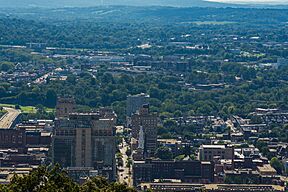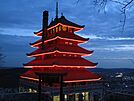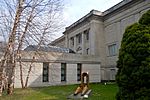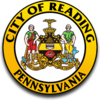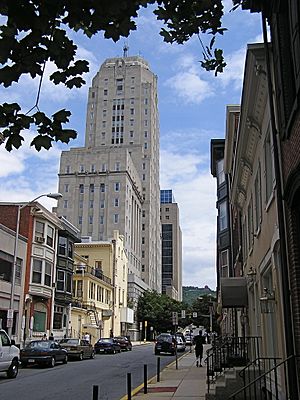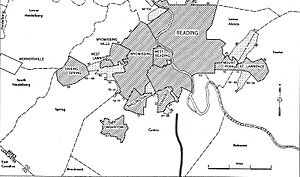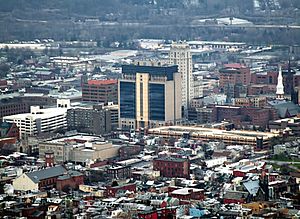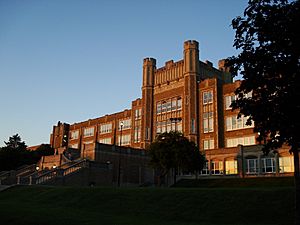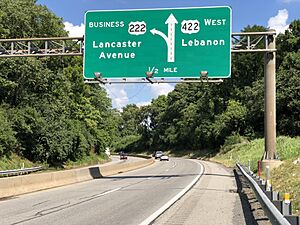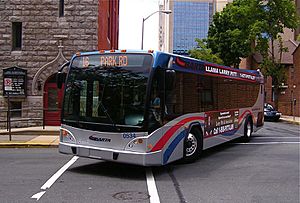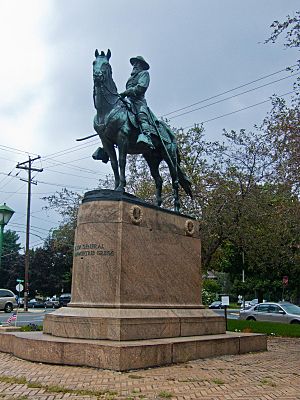Reading, Pennsylvania facts for kids
Quick facts for kids
Reading
|
|||
|---|---|---|---|
|
|
|||
|
|||
| Nickname(s):
Pretzel Capital of the World, Pretzel City
|
|||
| Country | United States | ||
| State | Pennsylvania | ||
| County | Berks | ||
| Founded | 1748 | ||
| Incorporated (borough) | September 15, 1783 | ||
| Incorporated (city) | March 16, 1847 | ||
| Named for | Reading, England | ||
| Area | |||
| • City | 10.08 sq mi (26.11 km2) | ||
| • Land | 9.84 sq mi (25.49 km2) | ||
| • Water | 0.24 sq mi (0.62 km2) | ||
| Elevation | 305 ft (93 m) | ||
| Population
(2020)
|
|||
| • City | 95,112 | ||
| • Estimate
(2022)
|
94,858 |
||
| • Density | 9,436/sq mi (3,642.7/km2) | ||
| • Urban | 276,278 (US: 149th) | ||
| • Urban density | 2,874.3/sq mi (1,109.8/km2) | ||
| • Metro | 428,849 (US: 126th) | ||
| Demonym(s) | Readingite, Redingensian | ||
| Time zone | UTC−5 (EST) | ||
| • Summer (DST) | UTC−4 (EDT) | ||
| ZIP Codes |
19601–19612, 19632, 19640
|
||
| Area code(s) | 610, 484 | ||
| FIPS code | 42-63624 | ||
|
Pennsylvania Historical Marker
|
|||
| Designated: | 1948 | ||
Reading (pronounced RED-ing) is a city in Pennsylvania, United States. It is the main city of Berks County. In 2020, about 95,112 people lived here. This makes Reading the fourth-largest city in Pennsylvania. It is smaller than Philadelphia, Pittsburgh, and Allentown. Reading is located in the southeastern part of the state. It is the main city of the Greater Reading area, which had over 420,000 residents in 2020.
Reading is famous for its history with the Reading Railroad. This railroad was very important for moving anthracite coal. It carried coal from Pennsylvania's Coal Region to big cities on the East Coast. The Reading Railroad is even one of the four railroad properties in the classic Monopoly board game!
Reading is also known as "The Pretzel City." Many pretzel bakeries are located here. Some famous ones include Bachman, Dieffenbach, Tom Sturgis, and Unique Pretzel. The Reading area is also a great place for cyclists. It has over 125 miles (201 km) of trails.
History of Reading
Early Days and Founding
The first people to live in the Reading area were the Lenape people. They were also known as "Delaware Indians."
In 1680, King Charles II of England gave a large piece of land to William Penn. This land became the Colony of Pennsylvania.
Reading was planned out in 1743 by Richard and Thomas Penn. They were sons of William Penn. They worked with Conrad Weiser. The town was named after Reading, England. It was officially started in 1748. When Berks County was created in 1752, Reading became its main city. Many people from southern and western Germany settled here. They bought land from the Penn family. The first Amish community in the New World was also in this area.
Reading During Wars
During the French and Indian War, Reading was a military base. It helped protect a line of forts along the Blue Mountain.
By the time of the American Revolution, the area's iron industry was very strong. It made more iron than England! This iron helped supply George Washington's troops. They got cannons, rifles, and ammunition from here. Reading was also a supply depot during the war. Hessian prisoners from the Battle of Trenton were held here.
In 1793, there was a Yellow Fever Epidemic in Philadelphia. Philadelphia was the capital of the United States then. President Washington thought about making Reading the emergency capital. But he chose Germantown instead.
Growth and Industry
From 1810 to 1950, Reading was one of the 100 largest cities in the U.S.
Canals helped Reading grow. The Schuylkill Canal was finished in 1825. It connected Reading to Philadelphia. The Union Canal was finished in 1828. It connected Reading to the Susquehanna River. But by the 1880s, railroads took over.
The Philadelphia and Reading Railroad (P&R) started in 1833. In 1877, a big railroad strike happened. Workers protested because their wages were delayed. Six men were killed in a clash with the National Guard. After many years of success, the Reading Company went bankrupt in 1971. This was due to less coal shipping and strict rules. In 1976, the Reading Company sold its railroad parts to Conrail.
In the early 1900s, Reading was part of the car and motorcycle industry. Companies like Daniels Motor Company, Duryea Motor Wagon Company, and Reading-Standard Company were here.
Recent Times
Reading grew steadily until the 1930s. Its population reached almost 120,000. But from the 1940s to the 1970s, the city faced tough times. This was because heavy industries and railroads declined. Many cities across the country also faced similar problems.
In 1972, Hurricane Agnes caused major flooding in Reading. The Schuylkill River overflowed. There was another flood in June 2006, but it was not as bad.
By the 2000 census, Reading's population stopped shrinking. More Hispanic residents moved in, many from New York City. Also, people from Philadelphia's suburbs started moving closer to Reading.
In December 2007, NBC's Today show featured Reading. They called it one of the top "Up and Coming Neighborhoods" in the U.S. They saw potential for growth and improvements.
Geography of Reading
Reading is located in southeastern Pennsylvania. It is about 65 miles (105 km) northwest of Philadelphia. The city covers about 10.1 square miles (26.1 km2). Most of this area is land, with a small part being water.
The Schuylkill River forms much of the city's western border. To the east, you'll find Mount Penn. Neversink Mountain is to the south. The area around Reading has many family-owned farms.
Reading's Population
Reading's population has changed over the years. In 1790, about 2,225 people lived here. By 1930, the population grew to over 111,000. Then, it slowly decreased for a few decades. However, by 2020, the population had grown again to 95,112.
In 2020, most of Reading's residents (68.9%) were of Hispanic/Latino background. About 18.9% were non-Hispanic White, and 8.5% were non-Hispanic Black.
Economy and Jobs in Reading
Reading and its nearby communities have many large employers. These include Boscov's (a department store), EnerSys, Carpenter Technology Corporation, Penske Truck Leasing, and Redner's Markets.
Programs like Jump Start Incubator and Berks LaunchBox help new businesses. They offer office space and support to people starting their own companies.
Here are some of the largest employers in the Berks County area as of 2017:
- Reading Hospital (6,878 employees)
- East Penn Manufacturing Co. (6,851 employees)
- Carpenter Technology Corporation (2,432 employees)
- County of Berks (2,370 employees)
- Reading School District (1,903 employees)
- Pennsylvania Government (1,886 employees)
- Wal-Mart (1,818 employees)
- Boscov's (1,740 employees)
- Penn State Milton S. Hershey Medical Center (1,566 employees)
- Penske Truck Leasing (1,535 employees)
Arts and Culture in Reading
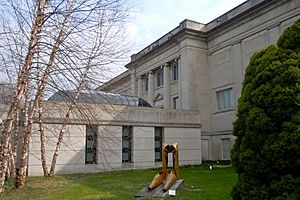
Reading has many cultural places. These include the Reading Symphony Orchestra and its youth orchestra. There's also the Reading Choral Society and the Berks Sinfonietta Chamber Orchestra. You can visit the GoggleWorks Art Gallery, the Reading Public Museum, and the Historical Society of Berks County.
Many famous artists and writers were born in Reading. These include graphic artist Jim Steranko, guitarist Richie Kotzen, and writers John Updike and Wallace Stevens. The famous marching band composer John Philip Sousa died in Reading in 1932. Artist Keith Haring was also born here.
In 1914, an anchor from the battleship Maine was placed in City Park. Franklin D. Roosevelt was there for the dedication.
Reading used to have many grand movie theaters. Today, the Rajah Shrine Theater is the only one left. It is now called the Santander Performing Arts Center. The Astor Theater was torn down in 1998. Its chandelier and gates are now in the Santander Arena.
The Mid-Atlantic Air Museum is at Carl A. Spaatz Field. It restores and displays old aircraft. Every year, the museum hosts a "World War II Weekend Air Show."
Did you know the mechanical ice cream scoop was invented in Reading in 1876? Also, the 5th Avenue candy bar and York Peppermint Pattie were invented here!
Fun Places to Visit
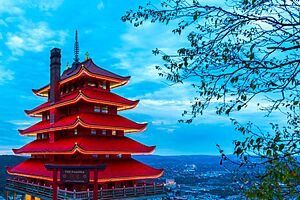
- The Pagoda: In 1908, a Japanese-style pagoda was built on Mount Penn. It looks over the city and is a popular tourist spot.
- William Penn Memorial Fire Tower: This tower is 120 feet (37 m) tall. It offers amazing views from 950 feet (290 m) above the city. You can see up to 60 miles (97 km) away!
- VF Outlet Village: This was the first outlet mall in the United States. It started in the 1970s. The VF Outlet closed in 2020.
- GoggleWorks Center for the Arts: This is a community art center. It used to be the Willson Goggle Factory. You can find art studios, galleries, a film theater, and a store here. Admission and parking are always free.
Sports in Reading
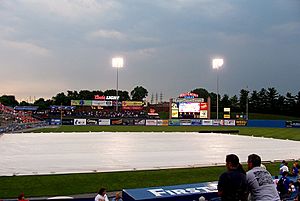
Reading has a rich sports history.
- Baseball: The Reading Fightin Phils are a minor league baseball team. They are connected to the Philadelphia Phillies. They play at FirstEnergy Stadium. Many famous players like Mike Schmidt played here.
- Soccer: Reading United AC is a top amateur soccer team. Many of their players have gone on to play professionally.
- Racing: Maple Grove Raceway hosts drag racing events. Duryea Drive, on Mount Penn, is used for the Duryea Hill Climb car race. It's named after Charles Duryea, who tested his early cars there.
Many professional athletes are from Reading. These include baseball player Carl Furillo, football player Lenny Moore, and basketball player Donyell Marshall. Golfer Betsy King, a member of the World Golf Hall of Fame, was also born here.
Here are some of Reading's sports teams:
| Club | League | Venue | Established | Championships |
|---|---|---|---|---|
| Reading Fightin Phils | Double-A Northeast, Baseball | FirstEnergy Stadium | 1967 | 4 |
| Reading Royals | ECHL, Ice hockey | Santander Arena | 2001 | 1 |
| Reading United AC | USL League Two, Soccer | Gurski Stadium | 1996 | |
| Reading Rebels | The Basketball League, Basketball | Santander Arena | 2022 |
Education in Reading
The Reading School District provides schools for the city's children. Reading Senior High School is one of the largest high schools in Pennsylvania. It serves grades nine through 12.
There are three high schools in the city:
- Berks Catholic High School (grades 9–12)
- Reading Senior High School (grades 9–12)
- Reading Intermediate High School (grade 8)
Reading also has four colleges and universities:
- Albright College
- Alvernia University
- Penn State Berks
- Reading Area Community College
Getting Around Reading
Reading has many roads and highways. U.S. Route 422 is a major road that goes around the city. It's called The West Shore Bypass. The Penn Street Bridge is a historic bridge that connects to downtown Reading. Other important routes include U.S. Route 222, Interstate 176, and Pennsylvania Route 12.
Public Transportation
The Berks Area Regional Transportation Authority (BARTA) provides public transit. BARTA operates buses on 20 routes. Most routes start at the BARTA Transportation Center.
Klein Transportation offers bus service from Reading to places like New York City. Transport Azumah also provides bus service to New York City. Amtrak Thruway bus service connects Reading to Philadelphia's 30th Street Station.
The Reading Regional Airport serves the area for general aviation. Commercial flights stopped in 2004.
Freight trains still operate in Reading. The Norfolk Southern Railway and other railroads serve the city. There are ongoing discussions about bringing passenger train service back to Reading. This would connect Reading to Philadelphia and New York City.
Utilities
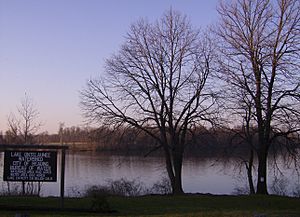
Met-Ed provides electricity to Reading. UGI Utilities provides natural gas. The Reading Area Water Authority supplies water from Lake Ontelaunee. The city's Public Works department handles sewer service, trash, and recycling.
Fire Department
The Reading Fire and EMS Department (RFD) protects the city. It has 135 firefighters and paramedics. They operate from seven fire stations. They use five Engine Companies, three Ladder Companies, one Rescue Company, and four Medic Ambulances.
Notable People from Reading
Many interesting people have come from Reading! Here are just a few:
- John Barrasso (b. 1952), a U.S. Senator.
- Daniel Boone (1734–1820), a famous frontiersman.
- Albert Boscov (1929–2017), who founded the Boscov's department store.
- Michael Constantine (1927–2021), an actor.
- John Fetterman (b. 1969), a U.S. Senator from Pennsylvania.
- Meg Foster (b. 1948), an actress.
- Carl Furillo (1922–1989), a Major League Baseball player.
- David McMurtrie Gregg (1833–1916), a Civil War general.
- Keith Haring (1958–1990), a famous artist and activist.
- Chad Hurley (b. 1977), who helped start YouTube.
- Betsy King (b.1955), a professional golfer in the World Golf Hall of Fame.
- Richie Kotzen (b. 1970), a rock guitarist.
- Donyell Marshall (b. 1973), a basketball player.
- Lenny Moore (b. 1933), an NFL running back and Hall of Famer.
- Jim Steranko (b. 1938), a comic book artist.
- Wallace Stevens (1879–1955), a poet.
- Taylor Swift (b. 1989), a famous singer-songwriter.
- John Updike (1932–2009), a Pulitzer Prize-winning novelist.
- Lonnie Walker IV, a professional basketball player.
Sister City
Reading has a sister city in Germany called Reutlingen. Students from Reading High School can visit Reutlingen as part of an exchange program. German students also visit Reading.
See also
 In Spanish: Reading (Pensilvania) para niños
In Spanish: Reading (Pensilvania) para niños


